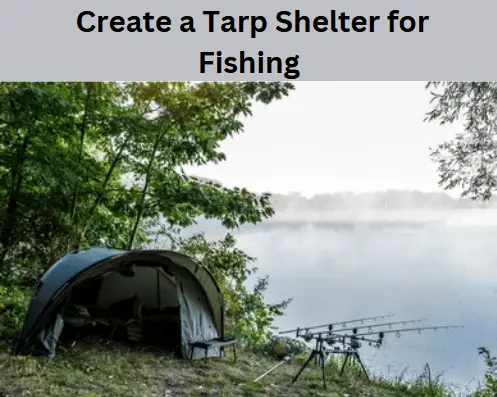To create a tarp shelter, select a suitable location and anchor your tarp securely using cords or stakes. In this article we wiil share complete guides about How to Create a Tarp Shelter for Fishing.
Choosing The Right Tarp
When creating a tarp shelter, it is important to choose the right tarp to ensure its effectiveness and durability. Consider the materials and durability of the tarp you are selecting. Look for high-quality materials such as reinforced polyester or polyethylene, which offer resistance to tearing and UV protection. Durability is crucial, as it ensures the tarp can withstand harsh weather conditions. Size and shape considerations are also key. Determine the size of the shelter you need based on the number of occupants and the equipment to be protected. Keep in mind that bigger tarps provide more coverage and allow for more maneuverability within the shelter. Additionally, choose a shape that suits your needs, such as square, rectangular, or hexagonal. Weight and portability are important factors to consider, especially if you will be carrying the tarp on outdoor adventures. Look for lightweight options that can be easily folded and packed. Tarps made with ripstop fabric are often lighter and more compact, making them ideal for backpacking and hiking.
Setting Up A Tarp Shelter
Creating a tarp shelter is an essential skill for outdoor enthusiasts and survivalists alike. When setting up a tarp shelter, selecting a suitable location is crucial. Look for a flat area free of rocks and debris. Avoid setting up near dead trees or under branches that could pose a safety risk. Next, consider the different configuration options for your tarp shelter. The most common setups include the A-frame, lean-to, and diamond shapes. Each configuration offers different advantages depending on the weather conditions and your specific needs. Once you’ve chosen the right configuration, it’s important to secure your tarp shelter properly. Use sturdy ropes or paracord to tie down the corners and sides. Make sure the tarp is taut to prevent it from sagging and collecting water. Remember, practice makes perfect when it comes to tarp shelter setup. Experiment with different configurations and locations to find what works best for you in various outdoor scenarios.
Essential Tips And Techniques
Essential Tips and Techniques: Using guy lines and stakes effectively: Guy lines and stakes are essential for creating a secure and sturdy tarp shelter. When setting up your tarp, make sure to use strong stakes that can withstand the tension and strain. Properly constructed guy lines will help distribute the weight and tension, ensuring that your shelter stays in place. To effectively use guy lines, tightly anchor them to the ground and attach them to appropriate points on the tarp. Adjust the tension to create a taut and stable shelter. Additionally, using shock cords can provide flexibility and resilience to your setup. Weatherproofing your tarp shelter: When creating a tarp shelter, it’s important to consider weather conditions. To make your shelter waterproof, apply a waterproofing spray or seam sealer to the tarp. This will help prevent leakage during rainy conditions. Using a double-layered tarp or adding a groundsheet can provide extra protection from rain, moisture, and cold. Choose a tarp made from durable and waterproof fabric and ensure it has reinforced grommets for added strength. Additionally, positioning your tarp at an angle can help shed water easily, preventing water from pooling and causing damage. Making adjustments for different conditions: Depending on the environment and weather, you may need to make adjustments to your tarp shelter. In windy conditions, ensure to securely fasten the tarp to prevent it from flapping or tearing. Adding extra support poles or reinforcing the corners can provide additional stability. During hot weather, consider setting up your tarp in a way that allows for adequate ventilation to keep the interior cool. Remember to inspect your tarp and guy lines regularly for any signs of wear or damage, and make necessary repairs or replacements.
Alternative Uses For Tarp Shelters
- Emergency Signaling and Rescue: In distress situations, a tarp can be used to create highly visible signals. By arranging the tarp in a way that it contrasts with the surroundings, it can catch the attention of potential rescuers passing by. The bright colors of the tarp, such as orange or yellow, are particularly effective for this purpose.
- Creating a Makeshift Rainwater Collection System: In survival situations where access to clean water is limited, a tarp shelter can be used to collect rainwater. By sloping one side of the tarp and placing a container or bucket underneath, you can gather and store rainwater for drinking or other purposes.
- Building a Basic Tarp Hammock: Tarp shelters can also be repurposed into makeshift hammocks. By tying the corners of the tarp to sturdy trees or posts, you can create a comfortable resting spot off the ground. This can be especially useful when camping in damp or rocky terrains.
Learn More
How To Fishing During The Rain
Last Word
Creating a tarp shelter is an essential skill for outdoor enthusiasts. With just a few simple steps, you can protect yourself from the elements and enjoy a comfortable camping experience. Remember to choose a suitable location, secure the tarp properly, and consider additional accessories for added comfort.
By following these guidelines, you can create a reliable and durable shelter that will serve you well on your outdoor adventures. So grab your tarp and get ready to embark on your next camping trip with confidence!

